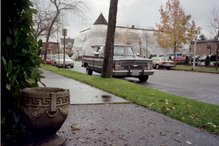When students wanted to study a foreign language in the 1960's, one barrier they faced was structure - for instance, of buildings. From the University of Washington Catalogue, Laura Jensen saw she could take Swedish, instead of French. To get permission, she went to Padelford Hall's three modern entrances that did not connect inside, to the elevator, marked in numbers and Braille, and went to the lower level, to Scandinavian Studies. It was Spring, 1968. At the dormitory in her desk light, it was a challenge to gaze at Swedish noun declensions.
A portrait of Nelson Bentley from the 1970's shows his desk in Padelford Hall in the 1970's, it is piled with student papers. It was January, 1972, Laura Jensen handed in her paper on Taylor to Whittier. On January 25, 1972, there were three feet of snow.
Snow snapshots at the rooming house she lived at then show Melissa at a third floor window, Tess with a dog by an icicle at the side kitchen door.
Another barrier - the card catalogue, many drawers in cabinets, led the search for Johan Ludwig Runeberg to a different part of Suzallo Library among Dewey Decimal System books. In February, 1972, Laura Jensen turned in her paper with eight poem translations in Scandinavian Culture.
Valiant Attempt, wrote Raymond Jarvi in red.
Scandinavian Culture had chair-desks with book racks under. American Immigrant descendants moved out - as waves when a pebble drops in water - and up, from city centers, in concentric rings.
In Spring, 1972, Laura Jensen's mother wrote that the Runeberg Choir would sing again at Point Defiance Park's Gardener's Paradise, that in 1971 it rained so hard they sang inside a greenhouse.

In Eighth Grade Laura Jensen chose French, not German or Spanish, because she was interested in art and her uncle was in World War One in France. Laura meant Laura in French. Others were awarded French names, Margaret became Marguerite, but Laura was Laura.
In a movie about college, High Time (1960), with Fabian and Bing Crosby, at a dance the band medleys briefly into The Best of Everything, a Johnny Mathis Hit. Johnny Mathis sang the title tune and appeared in a movie about college, A Certain Smile. He played a night club singer performing the title tune. The French girl at the Sorbonne came from Yonne by a river. Jaune means yellow, Rire Jaune means, a sickly smile. The Happy Face.
Bing Crosby, the fifty-plus fraternity pledge, arrived at the High Time dance in a horse-drawn carriage - he spills from the carriage door wearing a wig and a hoop skirt for he must impersonate a woman at a restored plantation mansion. This costume ball was a kind of Living History experience - such events brought to life dances and songs that had been written down from a hundred years earlier.
In April 2006 at Fort Nisqually rain fell in veils through trees, poured off gutters into 1850's rain barrels, a girl carried a stringed instrument in a shawl for songs under the porch roof. In the factor's house on the mantel a shell, a bust of Robert Burns (To A Mouse, Should Auld Acquainance Be Forgot), two women and a sewing machine patented in 1861.
It was the first mechanical thing I dealt with, a sewing machine. I jumped in and took it apart. I was always the one.
Laura Jensen interacts - Yes, family birth order place. Do you car pool? I've never owned a car, I use public transportation, walk, or ride a bicycle.
Everyone comes in on a bus at one October event. It happens in the nighttime.
What are the books?
Cookbooks. Aesop's fables. Orthography and Etymology, so important, things the little boys dragged in, and parlor games!
Their hair is up, their skirts gathered tight.
In 1990 Laura Jensen was taken in a car to a crafts and history museum in Finland. With cousins first she had seen the site where her grandmother was born, then the house that was reassembled, board by board, at the museum. A horse and rider went by. At the museum store she bought a record.
At Point Defiance in the 1990's there is wind in trees, waves on rocks, and Laura Jensen's plastic Yamaha recorder. A young person stops.
Did you write the songs you're playing?
The notes are black in the green music notebook. I copied them from a book. They're folk songs.
The young person walks on.
The songs were written down during a nineteenth century historic preservation project in Finland. The collection is extensive. They had been passed along person to person and in groups as tradition.
But it is dogma - that people can compose songs. Hoagy Carmichael, for example, composed Stardust. This proves that people can compose songs.
From 1988 to 1993, Laura Jensen did six dozen lyric translations from Swedish to English.


No comments:
Post a Comment